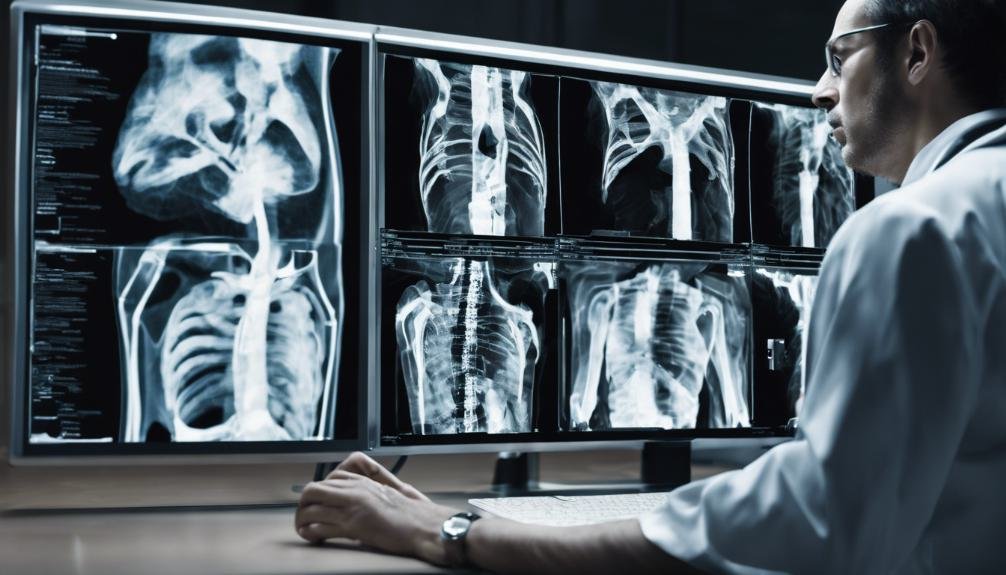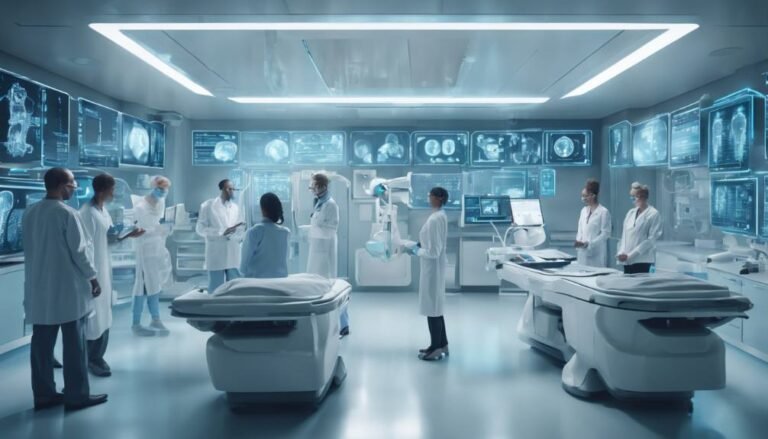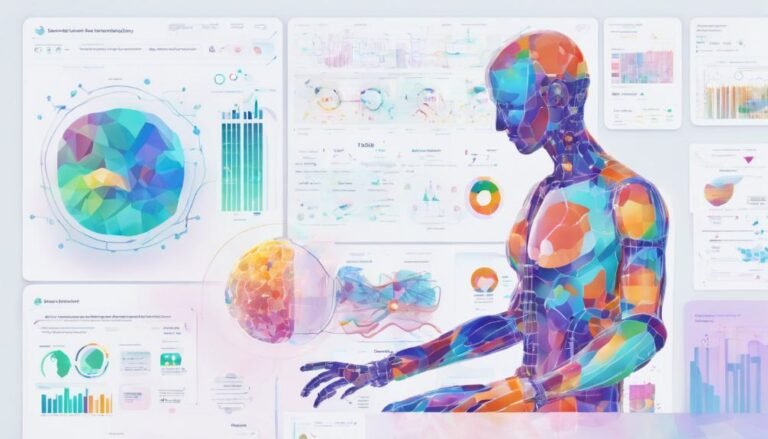AI for Radiology
Incorporating AI into radiology practices has undeniably transformed the landscape of medical imaging. Imagine a world where algorithms can assist in detecting minute abnormalities with unprecedented accuracy, potentially changing the way diagnoses are made. The integration of AI technology in radiology holds the promise of not only improving diagnostic precision but also revolutionizing treatment planning strategies. As advancements in AI continue to reshape the field, the implications for patient care and outcomes are vast and intriguing.
Key Takeaways
- AI enhances diagnostic accuracy in radiology.
- Improves workflow efficiency and patient outcomes.
- Utilizes advanced image analysis and machine learning.
- Reduces errors and unnecessary tests.
- AI algorithms optimize diagnostic accuracy.
Advantages of AI in Radiology
AI in radiology offers a multitude of benefits, revolutionizing the field with its ability to enhance diagnostic accuracy and efficiency. Through the integration of artificial intelligence (AI) technologies, radiology departments have witnessed significant advancements in several key areas.
To begin with, AI implementation has led to substantial cost savings by streamlining processes, reducing the need for manual intervention, and optimizing resource utilization. By automating repetitive tasks and flagging abnormalities, AI contributes to error reduction, enhancing the overall quality of patient care.
Moreover, workflow optimization is an essential advantage of AI in radiology. AI algorithms can prioritize and triage imaging studies based on urgency, ensuring that critical cases are promptly addressed. This not only improves the efficiency of radiology departments but also enhances patient care by reducing wait times for diagnoses and treatment.
Ultimately, the integration of AI technologies in radiology not only enhances diagnostic accuracy and efficiency but also yields tangible benefits such as cost savings, error reduction, workflow optimization, and patient care improvement.
Applications in Medical Imaging
In addition, as you explore the applications of AI in medical imaging, consider the significant image analysis advancements that have revolutionized the field.
AI algorithms have played a pivotal role in enhancing diagnostic accuracy by aiding radiologists in detecting subtle abnormalities.
Moreover, the integration of AI technologies has led to a notable improvement in workflow efficiency within radiology departments.
Image Analysis Advancements
Significant advancements in image analysis techniques have revolutionized the field of medical imaging, enhancing the accuracy and efficiency of diagnostic processes. Machine learning and pattern recognition algorithms have played a pivotal role in automating the analysis of medical images, allowing for faster and more precise identification of abnormalities.
Deep learning, a subset of machine learning, has further improved image processing by enabling computers to learn intricate features directly from the images themselves, without the need for manual extraction. This technology has been particularly successful in tasks such as tumor detection, organ segmentation, and disease classification.
Deep learning models, such as convolutional neural networks (CNNs), have shown remarkable performance in various medical imaging applications. These models can process vast amounts of image data, learning complex patterns and relationships that may not be easily identifiable to the human eye.
Diagnostic Accuracy Improvement
Enhancing diagnostic accuracy in medical imaging applications requires leveraging advanced image analysis techniques and machine learning algorithms. Machine learning plays an important role in improving diagnostic accuracy by enabling predictive modeling based on large datasets.
Through the use of deep learning algorithms, such as convolutional neural networks, radiologists can enhance image recognition capabilities, leading to more precise and efficient diagnoses.
With machine learning, predictive modeling can be employed to identify patterns and relationships within medical images that may not be immediately apparent to the human eye. By training algorithms on vast amounts of data, these models can learn to distinguish between subtle differences in images, aiding in the detection of abnormalities or specific conditions.
Deep learning, specifically in the field of image recognition, allows for the automatic extraction of features from medical images, reducing the potential for human error and variability in interpretation. As a result, the integration of machine learning and deep learning technologies into radiology workflows holds great potential for improving diagnostic accuracy and patient outcomes.
Workflow Efficiency Enhancement
To optimize workflow efficiency in medical imaging, implementing AI applications can streamline processes and improve overall productivity. Workflow optimization through AI integration involves automating repetitive tasks such as image sorting, report generation, and data entry. By leveraging AI algorithms, radiology departments can prioritize urgent cases, allocate resources efficiently, and reduce turnaround times for reports.
Radiologist collaboration is key to successful AI implementation in workflow enhancement. Radiologists can provide valuable insights to AI developers, ensuring that the technology aligns with clinical needs and workflow patterns. Through continuous feedback loops, radiologists can fine-tune AI algorithms to enhance accuracy and relevance in medical imaging interpretation.
AI integration in workflow efficiency enhancement also enables seamless communication between different healthcare systems, facilitating data sharing and interdisciplinary collaboration. By standardizing protocols and streamlining image analysis processes, AI can help radiologists focus on complex cases, ultimately improving patient care outcomes.
Embracing AI technologies in medical imaging workflow optimization is essential for modern radiology practices seeking to deliver high-quality, efficient healthcare services.
AI Algorithms for Diagnosis
AI algorithms for diagnosis offer the potential for improved diagnostic accuracy, enabling you to make more precise treatment decisions.
With these algorithms, you can expect quicker identification of abnormalities, leading to faster interventions and ultimately better patient outcomes.
The integration of AI in radiology can greatly streamline the diagnostic process, enhancing overall efficiency and effectiveness in healthcare delivery.
Improved Diagnostic Accuracy
Improving diagnostic accuracy in radiology through the utilization of advanced AI algorithms has shown significant promise in enhancing the efficiency and precision of medical diagnoses. Machine learning techniques, particularly deep learning algorithms, have revolutionized image interpretation by enabling computers to learn patterns and features from vast amounts of data.
These AI systems provide decision support to radiologists by highlighting potential areas of concern, aiding in the detection of abnormalities that may be overlooked or misinterpreted by human eyes.
Deep learning models excel in tasks like segmentation, classification, and detection within medical images, offering a level of accuracy and consistency that can complement radiologists' expertise. By analyzing images with a high level of detail and sensitivity, these algorithms assist in reducing diagnostic errors and improving overall patient outcomes.
The integration of AI into radiology practices not only streamlines workflow but also enhances the diagnostic capabilities of healthcare professionals, ultimately leading to more precise and timely diagnoses.
Faster Treatment Decisions
Utilizing advanced AI algorithms in radiology can greatly accelerate treatment decisions through rapid and accurate diagnosis. AI integration in clinical decision making processes enables treatment optimization by analyzing vast amounts of medical data swiftly and efficiently. By leveraging machine learning algorithms, radiologists can expedite the identification of abnormalities and recommend appropriate interventions promptly.
Through sophisticated data analysis, AI systems can assist in recognizing patterns and anomalies in medical images, leading to quicker and more precise diagnoses. This enhanced efficiency in diagnosis facilitates faster treatment decisions, ultimately benefiting patients by reducing the time taken to initiate appropriate therapies.
Furthermore, AI algorithms can streamline the workflow in radiology departments by automating certain tasks, allowing radiologists to focus more on interpreting results and making critical treatment decisions. The seamless integration of AI technology in radiology not only expedites the diagnostic process but also enhances the overall quality of patient care by enabling faster and more informed treatment decisions.
Enhancing Diagnostic Accuracy
To optimize diagnostic accuracy in radiology, advancements in artificial intelligence technology offer promising solutions. Machine learning algorithms, with their ability to analyze vast amounts of data, play a pivotal role in enhancing radiological diagnostics. By utilizing predictive analytics, these algorithms can assist radiologists in identifying patterns and trends that may not be immediately apparent to the human eye.
Deep learning, a subset of machine learning, further enhances diagnostic accuracy through advanced pattern recognition capabilities. Deep neural networks can sift through complex imaging data to detect subtle abnormalities that might be overlooked in traditional readings. This technology empowers radiologists by providing them with additional insights and supporting more accurate interpretations of medical images.
Incorporating AI-driven tools into radiology workflows can lead to more precise and efficient diagnoses. By leveraging machine learning and deep learning algorithms, healthcare providers can improve the quality of patient care and enhance diagnostic outcomes in radiology practices.
Impact on Patient Outcomes
Artificial intelligence in radiology has a significant impact on patient outcomes by enhancing diagnostic accuracy and facilitating timely treatment decisions. The integration of AI algorithms into radiological processes has shown to improve cost-effectiveness by reducing unnecessary tests and shortening hospital stays, leading to enhanced patient satisfaction.
AI aids in treatment planning by providing radiologists with detailed insights into disease progression and response to therapy, ultimately resulting in improved long-term outcomes for patients. By analyzing vast amounts of medical data quickly and accurately, AI systems assist in identifying subtle abnormalities that may be overlooked by human interpretation alone. This precision in diagnosis enables healthcare providers to tailor treatment plans more effectively, contributing to better patient outcomes and overall satisfaction.
Additionally, AI's ability to predict disease progression and response to treatment plays a vital role in enhancing long-term patient outcomes, ensuring excellent care management and improved quality of life for individuals undergoing radiological procedures.
Challenges and Limitations
Integrating AI into radiology processes poses several challenges and limitations that warrant careful consideration for best implementation. Regulatory compliance is a critical aspect that must be adhered to when using AI in radiology. Ensuring that AI systems meet the necessary legal and ethical standards can be complex due to the evolving nature of regulations in healthcare.
Another significant challenge is the limitations of training data. AI algorithms require vast amounts of high-quality data to be trained effectively. However, in the field of radiology, obtaining labeled datasets can be challenging due to issues such as privacy concerns, data security, and the need for expert annotation.
Overcoming these challenges requires a multi-faceted approach that involves collaboration between healthcare providers, AI developers, and regulatory bodies. Establishing clear guidelines for regulatory compliance and finding innovative solutions to training data limitations are essential steps towards successful integration of AI into radiology practices.
Future of Radiology Technology
Enhancements in imaging resolution and processing speed are shaping the future of radiology technology. AI integration and machine learning are key components driving these advancements.
AI integration in radiology is revolutionizing the field by improving diagnostic accuracy and efficiency. Future advancements will further enhance this integration, allowing for more sophisticated image analysis and interpretation.
Radiologist collaboration with AI systems will be essential in refining algorithms and ensuring accurate results. By working together, radiologists and AI can complement each other's strengths, leading to more precise diagnoses and personalized treatment plans.
Machine learning algorithms will continue to evolve, learning from vast amounts of data to improve their diagnostic capabilities.
The future of radiology technology holds the promise of faster, more accurate diagnoses, ultimately benefiting patient care. As AI continues to advance and integrate into radiology workflows, the field will see significant improvements in efficiency and effectiveness.
Collaborative efforts between radiologists and AI systems will play an important role in shaping this future landscape.
Ethical Considerations in AI
As radiology technology increasingly relies on AI integration and machine learning for advancements in diagnostic accuracy and efficiency, ethical considerations surrounding the use of AI in healthcare become paramount.
Data privacy is a critical concern when utilizing AI in radiology, as patient information must be safeguarded against unauthorized access or breaches. Ensuring that AI algorithms are designed to detect and mitigate biases is essential to prevent inaccuracies or discriminatory practices in diagnostic processes.
Accountability and transparency are key principles that must be upheld in the development and implementation of AI systems in radiology. Healthcare providers and developers must be accountable for the decisions made by AI algorithms and the outcomes they produce.
Transparency in the AI decision-making process is vital for building trust with patients and healthcare professionals, enabling them to understand how AI contributes to diagnostic assessments.
Conclusion
To sum up, AI in radiology has greatly enhanced diagnostic accuracy and patient outcomes.
Notably, a study found that AI algorithms can detect breast cancer with a 90% accuracy rate, surpassing human radiologists.
This statistic underlines the potential of AI technology to revolutionize the field of radiology and improve healthcare delivery for patients worldwide.
As AI continues to advance, the future of radiology looks promising with even more precise and efficient diagnoses.







